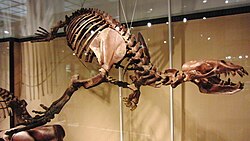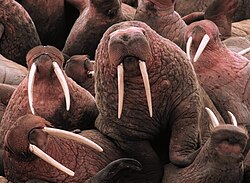species of pinnipeds and 102 species of fossil pinnipeds and their stem-relatives (Pinnipedimorpha), collectively referred to as pinnipedimorphs. Scientists...
28 KB (2,067 words) - 19:15, 25 March 2025
of arctoid carnivorans are the closest relatives to the pinnipedimorphs, being more closely related to musteloids. Below is an overall phylogeny of the...
6 KB (403 words) - 02:08, 11 December 2023
Titanotaria (category Fossil taxa described in 2018)
preserved fossil walrus currently known. Although the holotype specimen (OCPC 11141) of Titanotaria had been discovered in 1993 and represents one of the most...
10 KB (992 words) - 15:11, 24 May 2025
fixed. Conservation status codes listed follow the International Union for Conservation of Nature (IUCN) Red List of Threatened Species. Range maps are...
58 KB (1,942 words) - 01:41, 5 May 2025
Semantoridae (category Transitional fossils)
Semantoridae is an extinct family of stem-pinnipeds with fossils found in France, Kazakhstan, and Canada, dating back to various points in time in the...
2 KB (158 words) - 04:19, 11 December 2023
Desmatophoca (category Fossil taxa described in 1906)
the Oligocene, but without fossil samples obtained from this era, this is based primarily on conjecture. All samples of fossil Desmatophoca were found in...
9 KB (1,150 words) - 05:29, 4 January 2024
phylogeny and fossil record integration". Evolution. 78 (7): 1212–1226. doi:10.1093/evolut/qpae061. hdl:10141/623088. Berta, Annelisa. "Encyclopedia of Marine...
3 KB (261 words) - 03:53, 9 June 2025
Proneotherium (category Miocene mammals of North America)
lacked the long tusks of walruses, and were more slender and smaller than their modern relatives. Autapomorphies of Proneotherium fossils include a continuous...
3 KB (259 words) - 08:38, 18 November 2024
Frisiphoca (category Fossil taxa described in 2018)
extinct genus of phocid belonging to the subfamily Phocinae. It is known from fossils found in the late Miocene of Belgium. There are two species of Frisiphoca...
2 KB (191 words) - 18:08, 24 May 2021
Puijila (category Fossil taxa described in 2009)
Puijila, a very basal 'pinnipedimorph'. Ed Yong, Puijila, the walking seal — a beautiful transitional fossil. "Fossil seal had the feet of an otter" by Bob...
7 KB (636 words) - 01:19, 5 November 2024
Monotherium (category Fossil taxa described in 1874)
is an extinct genus of phocid belonging to the subfamily Monachinae. It is known from fossils found in the middle to late Miocene of Belgium. The type and...
2 KB (217 words) - 00:39, 5 November 2024
Amphicynodon (category Fossils of France)
Amphicynodon was an extinct genus of caniform carnivore. It has traditionally been considered an early bear, although recent evidence has suggested it...
3 KB (135 words) - 00:20, 2 May 2025
Allodesmus (category Fossils of Japan)
Allodesmus is an extinct genus of pinniped from the middle to late Miocene of California and Japan that belongs to the extinct pinniped family Desmatophocidae...
4 KB (288 words) - 23:23, 20 June 2025
Homiphoca (category Fossil taxa described in 1980)
genus of earless seals from the Pliocene of South Africa. The type species of Homiphoca, H. capensis, was originally described as a species of the dubious...
3 KB (272 words) - 20:34, 12 February 2024
Kamtschatarctos (category Pinnipeds of Europe)
is an extinct genus of pinniped that lived approximately 15.97 to 11.608 mya during the Early Miocene in the Kavran-Ukhtolok Bay of Russia's Kamchatka...
2 KB (161 words) - 22:35, 1 April 2025
Hadrokirus (category Fossils of Peru)
Hadrokirus is an extinct genus of true seal (Phocidae) that lived on the coast of Peru and North Carolina about 6 million years ago. The type species,...
2 KB (166 words) - 03:13, 5 May 2025
Amphicynodontinae are classified as stem-pinnipeds in the superfamily Phocoidea. Fossils of these mammals have been found in Europe, North America and Asia. Amphicynodontines...
7 KB (619 words) - 01:27, 7 January 2025
polyphyletic group of marine mammals, a few points of cranial and dental morphology suggested that the otarioids originated from a line of bears. One extinct...
3 KB (262 words) - 15:03, 29 January 2025
Enaliarctos (category Fossil taxa described in 1973)
Enaliarctos is an extinct genus of pinnipedimorph, and may represent the ancestor to all pinnipeds. The five species in the genus Enaliarctos have been...
5 KB (501 words) - 19:49, 18 November 2024
Pontophoca (category Fossil taxa described in 1941)
while fossils of P. jutlandica have been found in the Tortonian-age Gram Formation in Denmark. I. Koretsky. 2001. Morphology and systematics of Miocene...
1 KB (115 words) - 17:25, 24 May 2021
Amphicticeps (category Fossil taxa described in 1924)
journal}}: CS1 maint: numeric names: authors list (link) Morlo, Michael; Nagel, Doris (2006). "The carnivore guild of the Taatsiin Gol area: Hyaenodontidae (Creodonta)...
15 KB (1,183 words) - 14:21, 12 June 2025
Pliopedia (category Fossil taxa described in 1921)
by Robert Anderson, and consists of pieces of both forelimbs. Known Pliopedia fossils include a humerus, pieces of radius and ulna from both forelimbs...
2 KB (140 words) - 01:13, 5 November 2024
Ontocetus (category Fossil taxa described in 1859)
mammals fossils were being unearthed in Neogene deposits in the vicinity of Antwerp, Belgium as well as Suffolk, England. One of these fossils was identified...
8 KB (829 words) - 20:08, 18 November 2024
Osodobenus (category Fossil taxa described in 2020)
from crown walrus. Fossils of Osodobenus were discovered in the Californian Capistrano Formation, which also yielded the fossils of the walrus Pontolis...
10 KB (952 words) - 06:19, 28 May 2025
Drassonax (category Fossil taxa described in 1953)
Drassonax is an extinct genus of small, weasel-like bear. It lived in North America during the Early Oligocene, around 33 Ma. "†Drassonax Galbreath 1953...
799 bytes (39 words) - 23:52, 4 November 2024
Archaeodobenus (category Fossils of Japan)
Archaeodobenus is an extinct genus of pinniped that lived during the Late Miocene of what is now Japan. It belonged to the Odobenidae family, which is...
4 KB (468 words) - 23:44, 4 November 2024
Imagotaria (category Fossil taxa described in 1968)
extinct monotypic genus of walrus with the sole species Imagotaria downsi. Fossils of Imagotaria are known from the early late Miocene of California (c. 10-12...
3 KB (365 words) - 23:29, 4 November 2024
Valenictus (category Fossil taxa described in 1961)
discovered in 2024 from the Purisima Formation in Santa Cruz, California. The fossil was discovered by thirteen-year old, amateur paleontologist Forrest Sheperd...
2 KB (170 words) - 04:40, 28 May 2025
Gomphotaria (category Fossil taxa described in 1991)
Gomphotaria is a genus of very large shellfish-eating dusignathine walrus found along the coast of what is now California, during the late Miocene. It...
3 KB (217 words) - 00:26, 5 November 2024
Prototaria (category Fossil taxa described in 1984)
2021. Kohno, N.; Barnes, L.G.; Hirota, K. (December 1994). "Miocene fossil pinnipeds of the genera Prototaria and Neotherium (Carnivora; Otariidae; Imagotariinae)...
3 KB (297 words) - 08:40, 18 November 2024




















